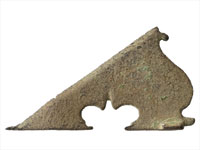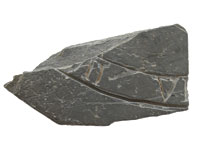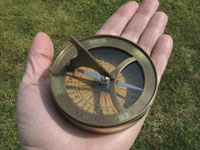A Nomenclature of Gnomons
The excavations at the St. John’s site have provided a unique peek into the world of scientific apparatus in the 17th century as used in the fledgling Maryland colony. One of the most striking examples of this comes in the form of a small, triangular brass object recovered in the later phases of the excavations.
The object is a gnomon – the part of a sundial designed to cast a shadow on the face of the dial to tell the time. This specimen was from a pocket sundial so it was designed to fold down so that the sundial could be closed up, not unlike a modern pocket watch. These pocket sundials often incorporated a compass so that the proper alignment could be achieved. Such pocket sundials are known from the 16th-century wreck of the English ship Mary Rose which sank on the 19th of July, 1545. Other examples exist from the Renaissance period and later in Europe.
One characteristic of sundial gnomons is that for the sundial to be accurate, the angle of the gnomon is supposed to be equal to the degrees latitude for which it is to be used. The Maryland colony sits at between 37° 53’ N to 39° 43’ N latitude. However, our gnomon measures approximately 30° 35’. This is the approximate latitude of the Mediterranean area and not far from the latitude of Jerusalem which was used to determine the prime meridian in the 17th century. Such a sundial would have been useful in sailing in the Mediterranean and also in sailing from the Europe to America using the route via the Caribbean.
In addition to the gnomon, the excavations at St. John’s recovered a part of a sundial face cut in slate and a fragment of a copper alloy object which may have been part of a sundial. Our gnomon will be displayed in the new St. John’s exhibit in a special case dedicated to new discoveries. Dick and Nan Wilson have kindly donated a reproduction pocket sundial which will be exhibited with our gnomon to provide context for the object.
Much of archaeology is driven by the need to provide chronological calibration to the deposits of refuse which tell the story of past activities at a site. It is unusual to discover an artifact that is about time itself! The gnomon offers unique insights into how time was measured in past times.

Gnomon

Slate sundial artifact

Pocket sundial


